Hosting my Minnesota family for Thanksgiving is something I look forward to all year. While my family members pitch in by bringing side dishes, rolls, and desserts, I always prepare the turkey. While my husband has tried fried turkey in the past, it’s always this classic method for oven roasted turkey that I come back to again and again. I know roasting a turkey can seem intimidating, but now that I’ve done it so many times, I think it’s actually the easiest recipe in a typical Thanksgiving dinner menu.

Recipe Highlights
15 minutes of prep time: Though some home cooks wake up in the wee hours of the morning to start prepping the Thanksgiving turkey recipe, I’ve never found that to be necessary. In fact, it takes me just 15 minutes (or less) to get the turkey ready and in the oven, and then the roasting time itself is just about 2 ½ hours for a typical size bird.
Simple, straightforward directions: I don’t call for any fancy equipment or unnecessary steps. My method for roasting turkey is plain, simple, and results in delicious turkey every time.
Crispy on the outside, juicy on the inside: This oven roasting method creates turkey that is just right. It has a nice crispy brown skin on the outside of the breast and legs while still having juicy, flavorful, and tender turkey on the inside.
No-baste method: Call me crazy, but I don’t think it’s necessary to baste a turkey with chicken stock or the turkey juices while it’s roasting. Instead, I prefer to let the turkey roast, undisturbed, before I check the temperature for the first time around the 90-minute mark. I always get a perfect Thanksgiving turkey, even without basting.
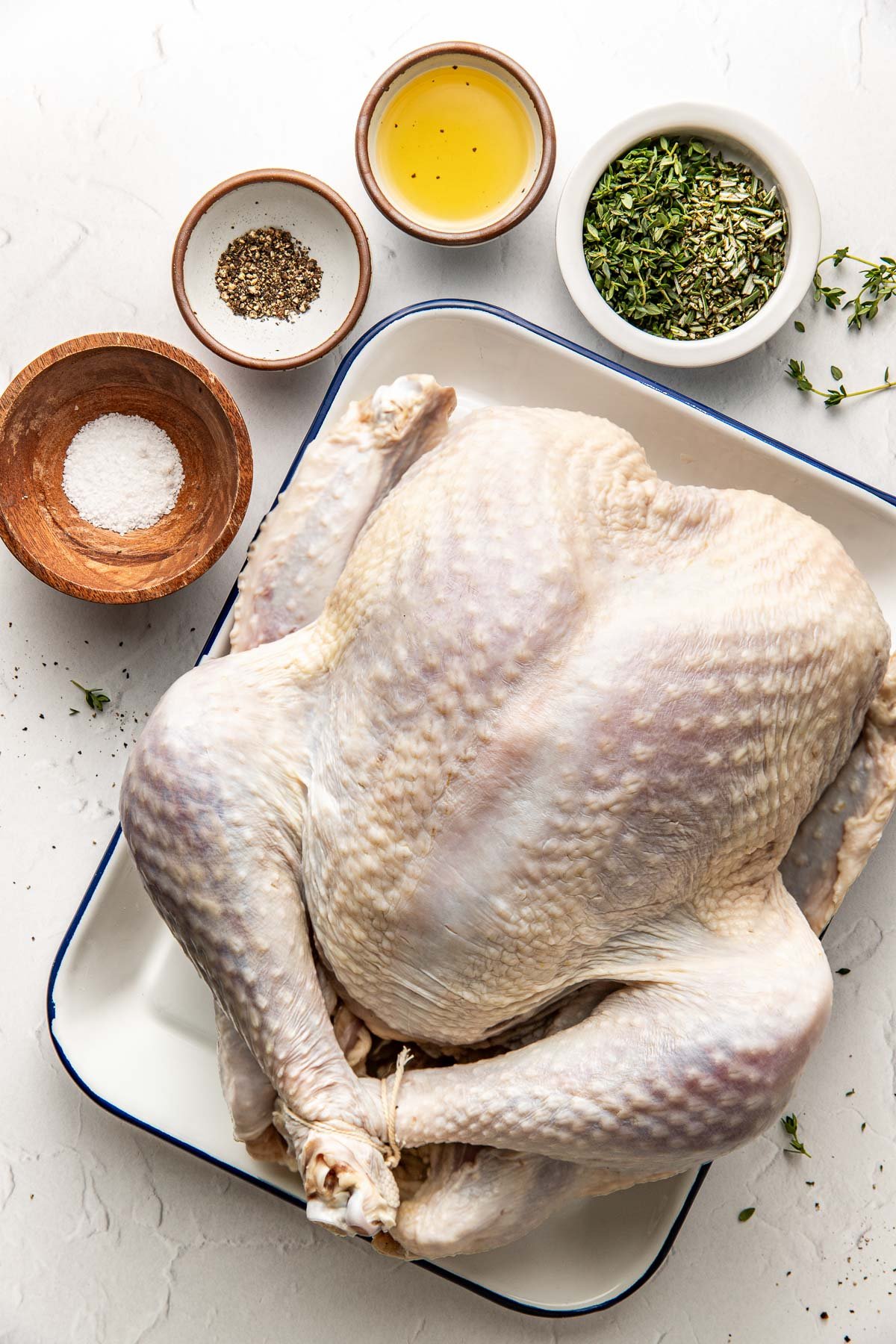

Ingredient Spotlight: Turkey
Turkey is undoubtedly a great source of high-quality protein, providing 32 grams per 4-ounce serving. But it’s also a great source of key vitamins and minerals, including B vitamins niacin (B3), vitamin B6, and B12. It’s also rich in selenium, phosphorus, and zinc. Turkey is also very lean, being quite low in saturated fat.
Dark meat turkey has slightly more calories and fat than white breast meat turkey. Dark meat also contains higher amounts of B vitamins, iron, and zinc.
Equipment Needed
- Paper towels – I use a few paper towels to pat dry the exterior and interior cavity of the turkey, which makes it easier to get the oil and herbs to adhere to it before roasting.
- Roasting pan – I think that a good quality roasting pan that comes with a rack and lid is well worth it in order to make the best turkey. I like to place the turkey on the inner rack to help elevate it above all the turkey juices, so it doesn’t get soggy. And I always add a lid so the turkey doesn’t get browned too quickly on the outside before it’s done on the inside. Alternatively, a roasting pan without a lid or a disposable aluminum pan will work, covered with aluminum foil, though the turkey will cook a lot faster.
- Digital thermometer – A few years ago I purchased a reliable meat thermometer, and it’s one of my most used kitchen tools. A digital thermometer is helpful for testing the internal temperature of the turkey and making sure it reaches a safe temperature of 165 degrees Fahrenheit.
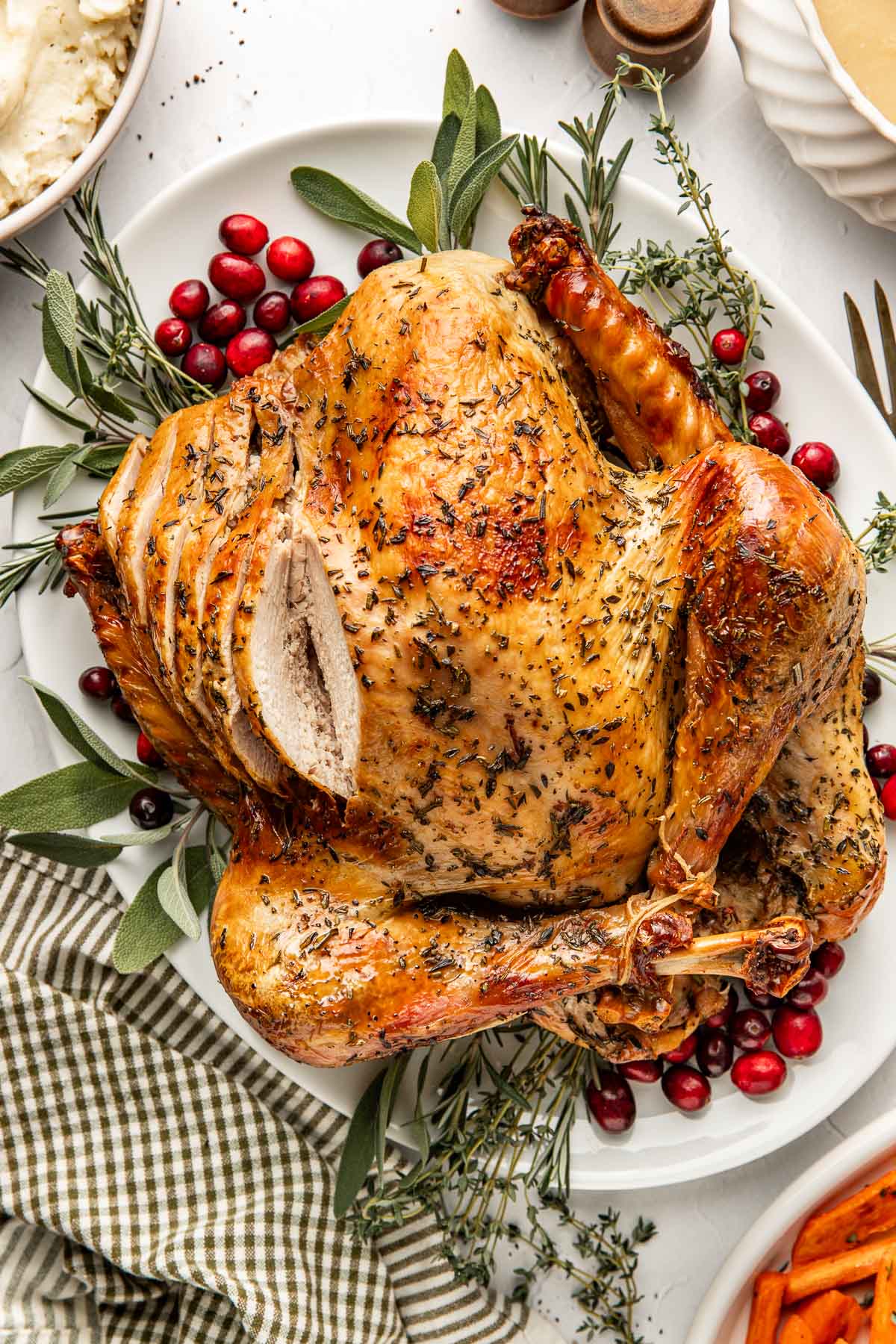
Time To Get Roasting
I’ve added more detail to the recipe card below, but here is an overview of the basic steps required to roast the best Thanksgiving turkey:
- Place turkey in a roasting pan: I place the turkey, breast side up, on the roasting rack in my roasting pan. I tuck the wings underneath and bring the legs together, tie them in place with kitchen twine (this isn’t necessary, but creates a nice look for the finished turkey).
- Season the turkey: I rub olive oil all over the turkey and then press the aromatic fresh herbs, like fresh rosemary, fresh sage, and thyme sprigs, on the turkey breast and legs, and I season it all over with kosher salt and pepper.
- Cover the roasting pan: I place the lid on top of the roasting pan and place the turkey in the middle rack in the preheated oven.
- Roast the turkey: Finally, it’s time to just let the turkey cook away. I try to disturb the turkey as little as possible while it’s roasting. At about 90 minutes, I check the temperature for the first time, inserting a meat thermometer into the thickest part of the turkey breast and thickest part of the thigh to check the temperature. When the turkey reaches 165℉ in both places, then I know it’s done.
For serving size and the complete directions and ingredient amounts, scroll down to the recipe card below. All of our recipes include the nutrition analysis, listing calories (kcals), protein, carbohydrates/carb, fiber, sugar, sodium, cholesterol, and more per serving.

Brine The Turkey
I started using a brine when roasting my turkey and I love the results every time. I find that brining the turkey in a seasoned salt water solution for 12 to 24 hours before roasting it results in a bird that is flavorful, juicy, and so tender. See my step-by-step brined turkey recipe tutorial here.
Cut, Plate, And Serve With Sides
When the turkey is done roasting and has reached an internal temperature of 165℉ in the thickest part of the breast, then I pull the roasting pan out of the oven. I let the turkey rest for at least 10 minutes, still with the roasting pan lid on top, to help the juices redistribute.
Next, I carve the beautiful golden brown bird on a cutting board and place the pieces on a serving platter before bringing it to the table. I cut through the skin of the turkey to get slices of the breast white meat first, then I remove the wings and legs and place those on the platter, too. Then I also add some dark meat and arrange the pieces so my guests can each find a piece of turkey that looks just right.
I set the turkey platter on the table in the middle of all of my other Thanksgiving classics, including my Nan’s stuffing recipe, garlic mashed potatoes, turkey gravy, cranberry sauce, and veggies like roasted carrots and roasted green beans. It’s such a beautiful presentation that I always want to snap a photo of it before we all dig in just to capture the moment.
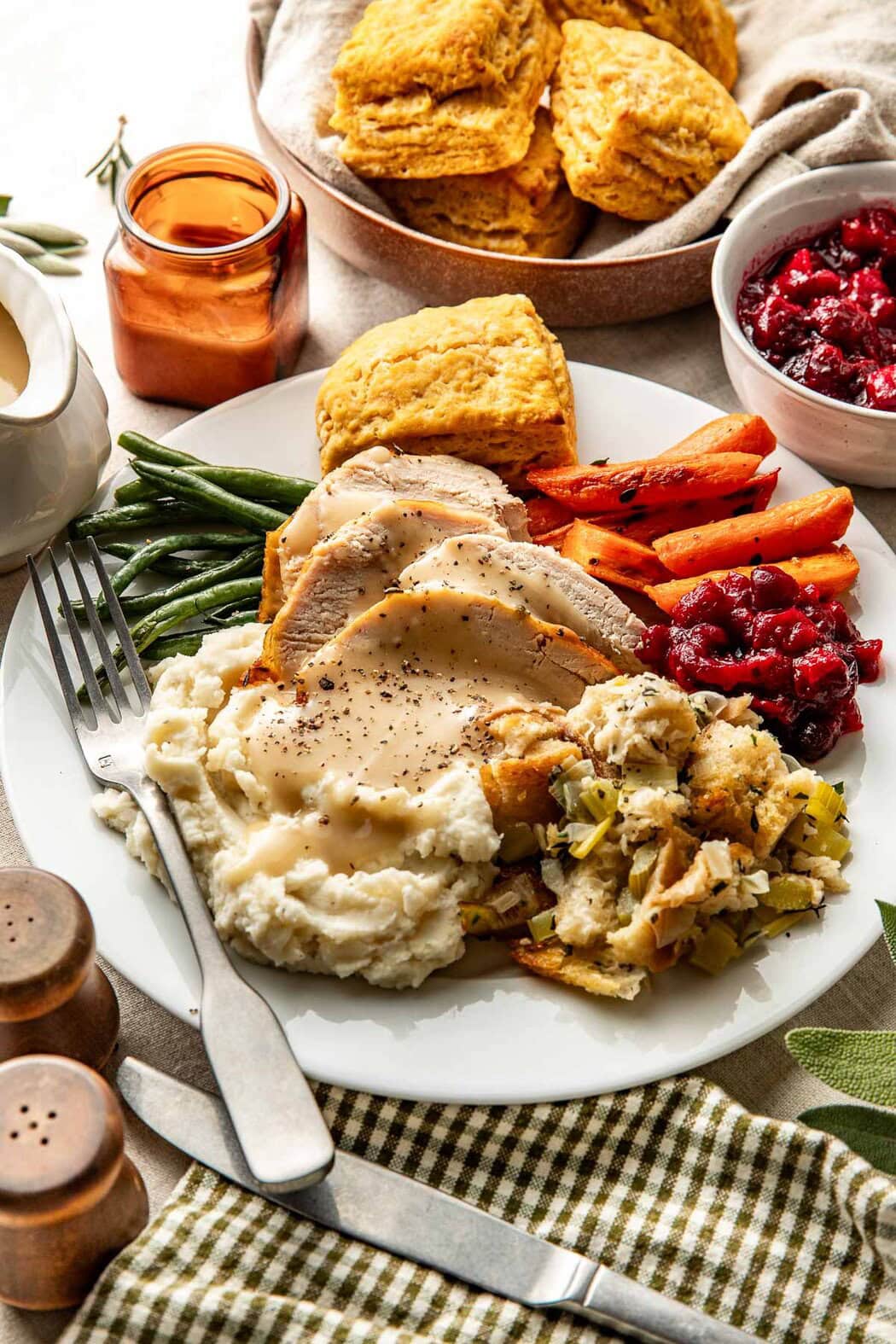
If There Are Any Leftovers
Once the Thanksgiving feast is done, I pull any remaining turkey from the bone, not wanting any of it to go to waste. I package the leftover turkey in an airtight container and refrigerate it for up to 4 days.
I enjoy the leftover turkey chilled or at room temperature or I reheat some with other Thanksgiving recipe leftovers. But most often, I use leftover turkey to make turkey soup or use in recipes that call for shredded chicken, such as this delicious pot pie casserole. I always keep the bones to make a batch of homemade bone broth because it’s nourishing and a great way to stretch my food budget.
Frequently Asked Questions
The best and safest way to thaw a frozen turkey is to place it in a refrigerator inside of a large bowl or pan for a few days before brining and/or roasting the bird. I find that it takes about 3 days to thaw a 12- to 15-lb turkey, then another 24 hours to brine it. Therefore, I typically place a frozen turkey in the refrigerator 4 to 5 days before I plan to roast it.
I prefer wet brining, as it seems to be a better method for getting flavor more deeply inserted into the turkey meat. I also think a salty liquid brine solution is optimal for getting juicy and tender turkey.
The best way to prevent a turkey from drying out is to avoid overcooking it. On average, it will take about 13 minutes per pound of turkey. But that can vary quite a bit depending on the reliability of the oven temperature, the thickness and quality of the roasting pan, and if the pan is covered. I also find that brining a turkey before roasting it helps create a juicier interior.
Rubbing an herb butter underneath the turkey skin before roasting is another way to create a juicy turkey. Gently lift and spread fingers between the turkey skin and breast meat, then rub the softened butter mixture underneath.
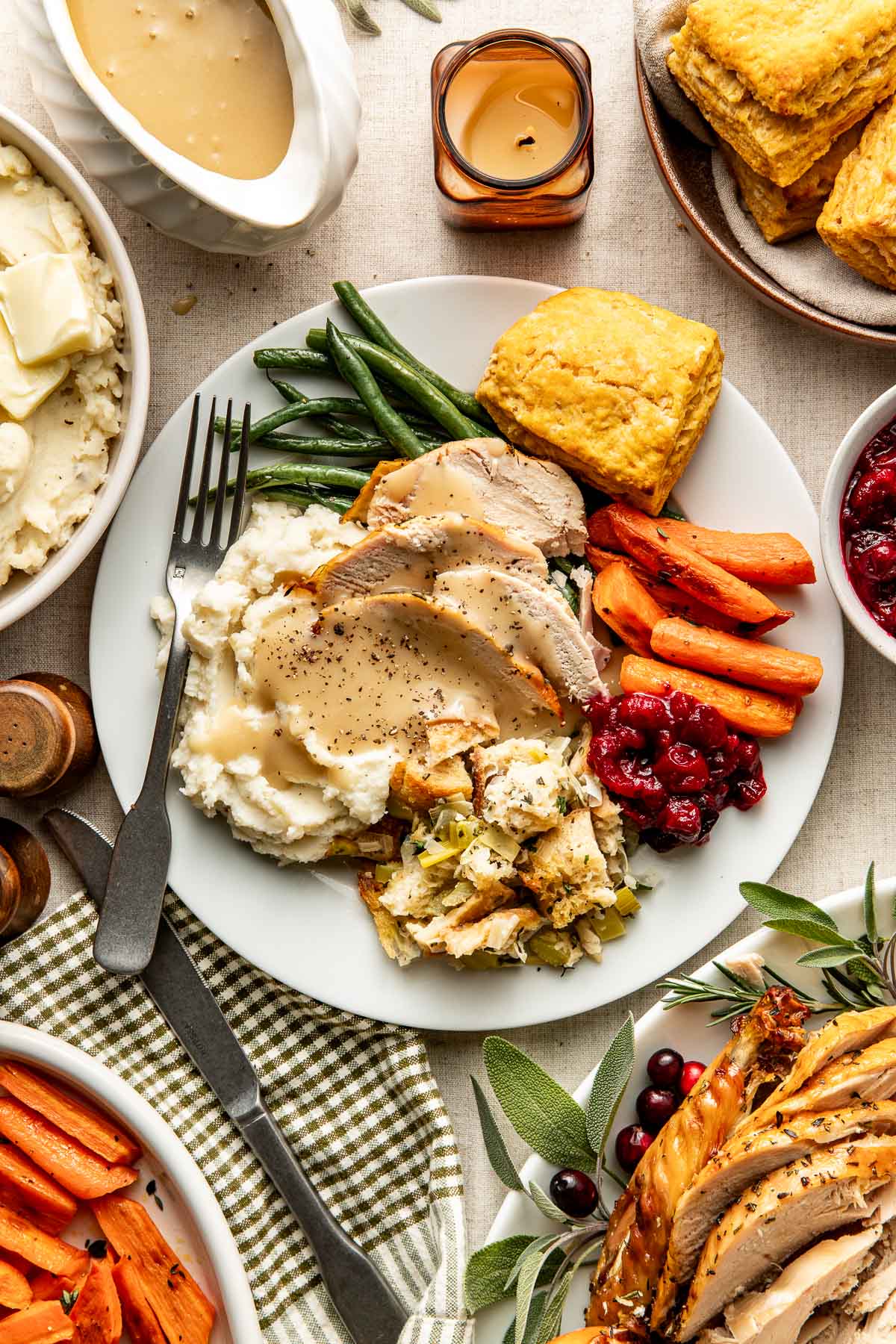
Want to save this recipe?
Enter your email below & we’ll send it straight to your inbox. Plus you’ll get great new recipes from us every week!

Whole Turkey Recipe
This simple roasted turkey recipe is straightforward and easy, even for first-time turkey roasters. It’s a method I have used for years and always results in turkey that is beautifully browned on the outside while being flavorful and juicy on the inside.
Ingredients
Instructions
- Preheat the oven to 350℉.
- Remove the giblets or any seasoning packet from inside the turkey.
- Pat the turkey dry, inside and out, with paper towels. Tuck the wing tips underneath the body to prevent them from burning. If you’d like to tie or pin the legs together, do that, but it’s not necessary.
- Place the turkey, breast side up, in a roasting pan with a rack and a lid.
- Using your hands, rub the oil all over the outside of the turkey breast, legs, and wings. Then season with the thyme, rosemary, salt, and pepper, pressing the herbs slightly into the skin.
- Cover the pan with the lid and roast the turkey. The total cook time will depend on the weight of the turkey, and it should cook for about 13 minutes per pound. For example, a 15-lb turkey will roast for almost 3 ½ hours. However, depending on the thickness of your roasting pan, temperature accuracy of your oven, and whether or not the roasting pan has a lid, the time will vary. The turkey is done when a digital meat thermometer inserted into the thickest part of the breast reads 165℉. I recommend starting to check the turkey after 90 minutes and then continue cooking, as needed.
- When the turkey registers at 165℉ in the thickest part of the breast, remove the roasting pan from the oven. Allow the turkey to rest inside the covered roasting pan at least 10 minutes before cutting and serving.
- If desired, use the pan drippings to make turkey gravy.
- Store leftover turkey in an airtight container in the fridge for up to 4 days.
Last Step! Please leave a review and rating letting us know how you liked this recipe! This helps our business thrive so we can continue providing free recipes and high-quality content for you.
Notes
* I recommend brining the turkey for 12 to 24 hours before roasting. See my easy turkey brine recipe.
While I recommend using fresh herbs for this recipe, dried herbs will work. If using dried herbs, sub in half the amount of the fresh herbs. For example, instead of 1 ½ tablespoons (which is 4 ½ teaspoons) of fresh thyme, use 2 ¼ teaspoons of dried thyme.
The turkey can be roasted directly in the bottom of a shallow pan without a lid or in a disposable aluminum pan that is covered with foil. However, the turkey will likely cook faster in this vessel, especially if a rack and lid is not used, so watch it carefully and start checking after 90 minutes of roasting. If covering with aluminum foil, I recommend removing the foil for the last 10-20 minutes to get a crispier brown crust.
Nutrition Information
- Serving Size: 4 ounces roasted turkey breast without skin
- Calories: 155
- Fat: 3 g
- (Sat Fat: 1 g)
- Sodium: 300 mg
- Carbohydrate: 0 g
- (Fiber: 0 g
- Sugar: 0 g)
- Protein: 32 g
- Cholesterol: 110 mg
Dietary
The photos in this post were taken by Megan McKeehan.
For ultimate success, we highly recommend reading the tips in the full blog post above. All photos and content are copyright protected. Please do not use our photos without prior written permission. If you wish to republish a recipe, please rewrite the recipe in your own unique words. Link back to the source recipe here on The Real Food Dietitians. Thank you!
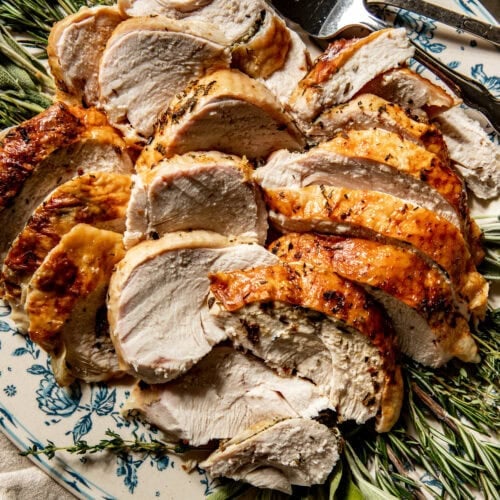

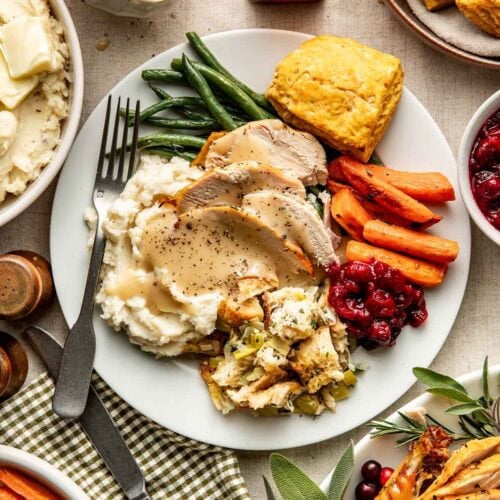
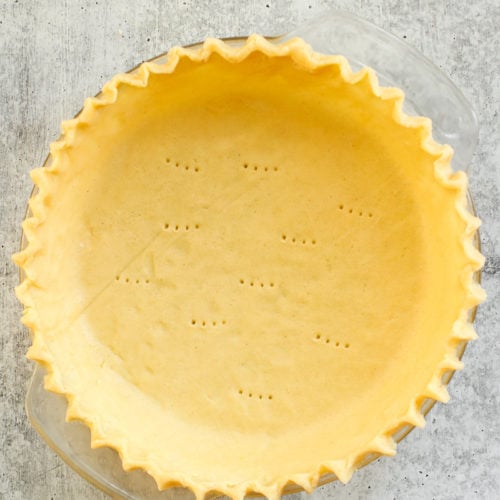
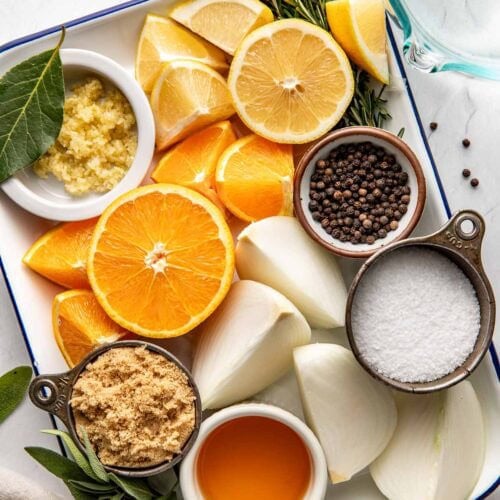

My first turkey! I used the brine and the gravy recipes too. I got nervous because I was reading that liquid brine isn’t a good idea. Wrong! It was amazing! I’ll do it all gain next year!
We are so happy to hear it, Liz! Thank you for the great feedback and 5-star review!